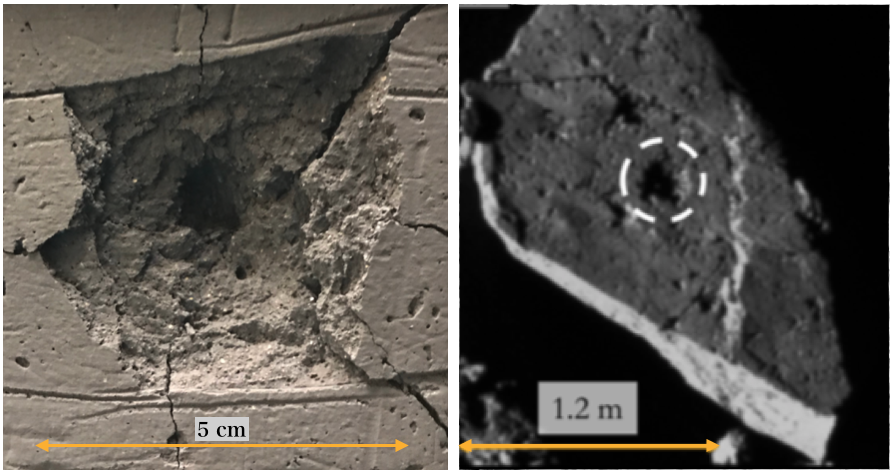Post-Doctoral Researcher
Theory and Observations in Planetology (TOP) group - Laboratoire Lagrange
Contact
Post-Doctoral Researcher
Theory and Observations in Planetology (TOP) group - Laboratoire Lagrange
Contact
Address: Bd de l'Observatoire, CS 34229 - F 06304 NICE Cedex 4
Office: PHC-S04
Tel: +33492003043
e-mail: chrysa.avdellidou@oca.eu
personal webpage:
Scientific Interests
I am a planetary scientist and my work focuses on the physical properties of small bodies and the most violent process that acts on them, impacts. I studied Physics at the Aristotle University of Thessaloniki (Greece) and in 2016 I obtained my PhD on experimetnal hypervelocity impacts from the Impact Lab of the University of Kent (UK), where I still hold a visiting position. I was a Research Fellow at ESTEC/ESA where I studied the meteoroid impacts on the lunar surface. In 2018 I obtained a Research Fellowship at the Observatory of Nice in order to work on the asteroid physical properties and expand the local database, which is currently the largest in the world. If you are interested in physical properties of asteroids please visit our database: Minor Planet Physical Properties Catalogue (MP3C). I am a collaborator at the OSIRIS-REx sample return space mission (NASA) to the NEA asteroid Bennu and at MIRS instrument (CNES) of the Martian Moon eXploration sample return mission to Phobos (JAXA).
The main focus of my work is on experimental hypervelocity impacts. I have shown that the impacting body contaminates the target with its material, in amounts that depend on the impact speed and the porosity of the target (Avdellidou et al. 2016, 2017). These lab results were used to understand the presence of the hydration band on the metallic asteroid Psyche (Avdellidou et al. 2018) and the pyroxene boulders on the surface of asteroid Bennu (DellaGiustina et al. 2021). I addition, I study the crater formation on differnet materials, the generation of impact flashes and the amount of produced fragments. In my experiements I try to use materials that can be found on small bodies in order to have a good analogue process. I was the fιrst who used simulant materials for the dark carbonaceous asteroids (C-types) in order to study the production of small craters on the rocks of asteroids Bennu and Ryugu, targets of the sample return space missions.  Survival of olivine projectile after hypervelocity impacts onto water ice targets.
Survival of olivine projectile after hypervelocity impacts onto water ice targets.

Left: Impact crater on the CM2 asteroid simulant built at the Exolith Lab. Hypervelocity impacts are done at the Impact Lab of the University of Kent, UK (Avdellidou et al. 2020); Right: Mini-crater on a surface boulder of the carbonaceous asteroid Bennu (Ballouz et al. 2020).
Some of the original small bodies that formed the planets, the planetesimals, survived and are still present in the asteroid belt. However, many of those survivors during the history of the solar system broke due to impacts and created the asteroid families! By studying these families we learn about the formation and evolution of this first generation of solar system small bodies. My interest is focused to compositionally characterise the asteroid families by studying their spectra. Our team (project ORIGINS) has discovered three old families in the inner part of the Main Belt, which we are currently characterising. By studying the asteroid families is like "looking inside" the original planetesimals allowing us to understand their formation and evolution.
I work on the analysis of the light (flash) that is generated when a meteoroid impacts the lunar surface. Using the luminous energy of the event, the time and the location of the impact I estimate the masses and sizes of the cm/dm-sized meteoroids. Thanks to the financial support from the National Program of Planetology (PNP) and the Universtiy of Nice, we are developing our observational setup at the site of Mt. Gros in Nice. On May 27th 2020 we observed our first lunar flash caused by the impact of a sporadic meteorid on the lunar surface. Our target is to locate, using spacecraft images, the fresh craters on the lunar surface produced by the observed impacts. In that way we can link the size of the impacting meteoroid to the size of the crater.
UMR LAGRANGE
Observatoire de la Côte d’Azur
Boulevard de l’Observatoire
CS 34229 - F 06304 NICE Cedex 4
Tél. : +33 (0)4 92 00 30 11
Fax : +33 (0)4 92 00 30 33